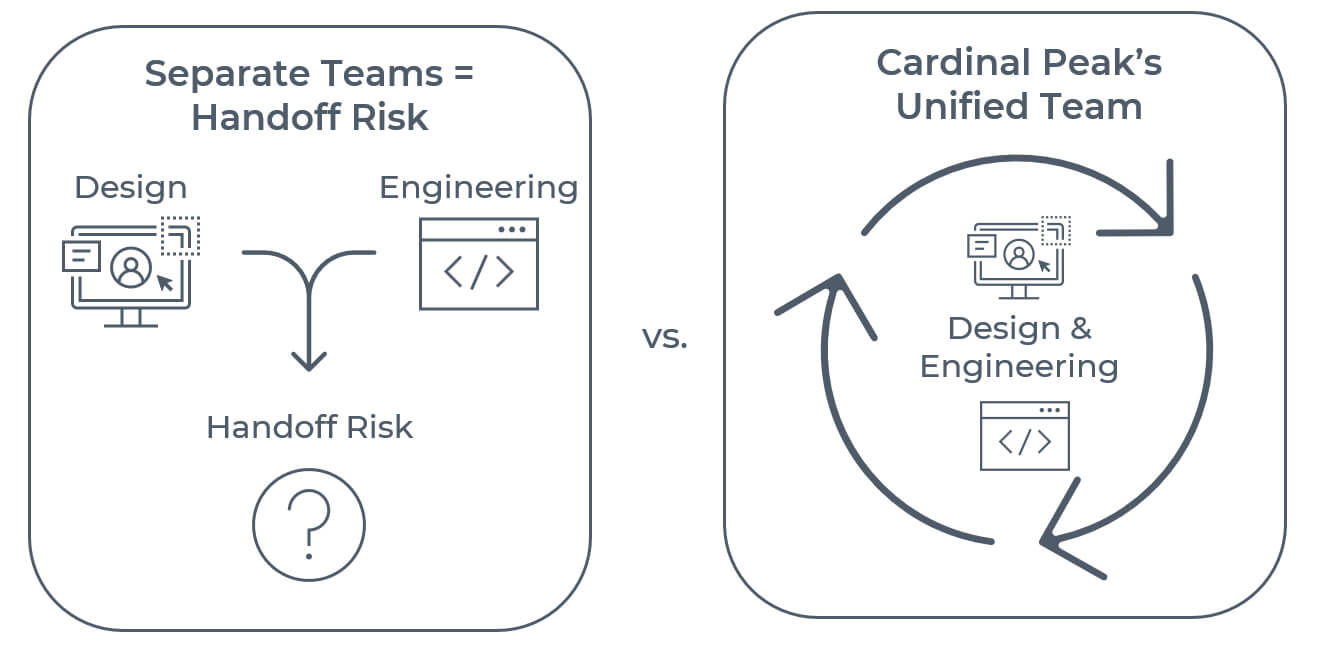Even the most innovative UI design can fail in its implementation. The designer-to-developer handoff is a critical point of failure that introduces costly delays, frustrating rework, and a final product that falls short of the original vision. Ambiguous specifications, missing assets, and a lack of shared understanding can lead to a final product that is a pale imitation of the original vision.
This is a challenge that can’t be solved with better software alone; it requires a better process. A seamless handoff is built on a foundation of clear communication, deep mutual respect between disciplines, and a shared language. At Cardinal Peak, we’ve built our UI engineering services around this philosophy, creating a process that ensures the transition from pixel to product is flawless.
Contents
The Problem: When “Developer-Ready” Isn’t Ready
Many a UI UX Design agency will deliver a folder of assets and a link to a Figma or Sketch file, calling it “developer-ready.” However, this often leaves engineers with critical questions:
- How should this element behave on interaction? (e.g., hover states, press states)
- What is the intended animation or transition timing?
- How should this design adapt to different screen sizes or states?
- Are these assets optimized for our specific hardware and memory constraints?
- Are the design tokens and variables clearly defined for easy integration?”
Without clear answers, engineers are forced to make assumptions, leading to a product that is functionally correct but experientially wrong. This is where the gap between a design concept and its software implementation begins.
The Solution: A Living Handoff Built on a Shared System
The solution is to stop thinking of the handoff as a single event and start treating it as a continuous, collaborative process. This is where a robust Design System becomes invaluable. The contrast between this unified approach and the traditional siloed model is clear in the figure below.
The Integrated vs. Siloed Development Model

As we’ve discussed before, a Design System is a single source of truth for both designers and developers. At Cardinal Peak, our approach to user interface design services ensures that when a designer uses a “button” component in Figma, it directly corresponds to a “button” component in the engineers’ code repository. The specifications for color, typography, spacing, and interaction are already built-in and understood by both teams. This eliminates ambiguity and dramatically reduces the chance of error.
To read more about Figma and UI tools, check out our blog post on The Tools and Technologies That Power Our UI Design Process.
The Cardinal Peak Advantage: A Unified Team
The ultimate way to de-risk the handoff is to eliminate it entirely. When your UI designers and software and embedded engineers are part of the same team, the dynamic shifts from a transactional delivery to a true partnership.
- Continuous Dialogue: Our designers don’t just throw designs over the wall. They have ongoing conversations with the engineering team, validating technical feasibility and optimizing for hardware constraints throughout the design process.
- Deep Technical Empathy: Our UI designers understand the challenges of embedded systems. They provide designs that are efficient and considerate of the hardware’s limitations.
- Unified Accountability: When you partner with a single firm for both user interface consulting and implementation, there is no finger-pointing. Our team takes collective ownership of the final product’s success, ensuring both the design’s vision and the engineering’s integrity are upheld.
Conclusion: From Vision to Reality, Seamlessly
Acing the designer-to-developer handoff is less about finding the perfect tool and more about fostering a culture of deep collaboration and unified ownership. By building on a shared design system and uniting design and engineering talent on a single team, you can ensure that your product’s vision is translated into a high-quality, real-world experience without compromise.
Ready to eliminate handoff risk and ensure your product vision becomes a reality? Schedule a consultation with our team to discuss a unified approach to your product’s design and implementation. Learn more about our end-to-end UX concept to post-launch process.
